Print this Page
U.K. Kwanzaa Campaign
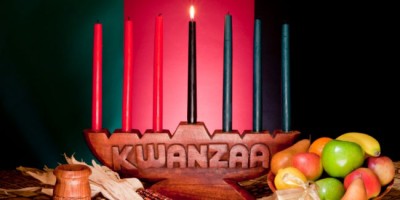
[su_spoiler title=”LEARN ABOUT THE U.K. KWANZAA CAMPAIGN” style=”fancy” icon=”plus-square-1″][su_tabs][su_tab title=”ABOUT KWANZAA”]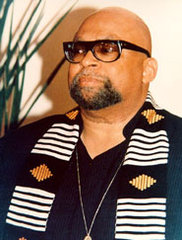 KWANZAA, is an African-American cultural festival conceived and developed by Dr. Maulana Ron Karenga and was first celebrated on December 26, 1966. Today KWANZAA is celebrated by many millions of African people throughout the world.
KWANZAA, is an African-American cultural festival conceived and developed by Dr. Maulana Ron Karenga and was first celebrated on December 26, 1966. Today KWANZAA is celebrated by many millions of African people throughout the world.
KWANZAA is traditionally celebrated from December 26th through to January 1st, each of these seven days are focused upon the NGUZO SABA, or the seven principles. Derived from the Swahili phrase “matunda ya kwanza” which means “first fruits”, the KWANZAA Festival is rooted in the first harvest celebrations practiced in various cultures throughout Africa.
This festival seeks to establish a positive connection to African culture and tradition, by providing a focal point for the gathering of African people to reflect upon the NGUZO SABA, or the seven principles.
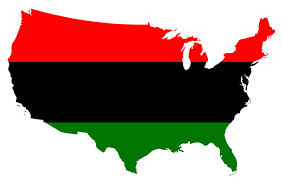 These seven principles were adopted by Dr Karenga “to introduce and reinforce seven basic values of African culture which contribute to building and reinforcing family, community and culture among African American people as well as Africans throughout the world African community”. The NGUZO SABA therefore stands at the heart and origin of KWANZAA and reflects the similarity found in the moral, spiritual, social, communal codes and value systems adhered to within traditional African customs, found and practiced throughout the continent. Serving therefore as a set of principles that can help to maintain and sustain African people and their communities over many more millennia.
These seven principles were adopted by Dr Karenga “to introduce and reinforce seven basic values of African culture which contribute to building and reinforcing family, community and culture among African American people as well as Africans throughout the world African community”. The NGUZO SABA therefore stands at the heart and origin of KWANZAA and reflects the similarity found in the moral, spiritual, social, communal codes and value systems adhered to within traditional African customs, found and practiced throughout the continent. Serving therefore as a set of principles that can help to maintain and sustain African people and their communities over many more millennia. Africans and friends of Africans of all religious faiths and backgrounds celebrate Kwanzaa.[/su_tab] [su_tab title=”THE U.K”]
Africans and friends of Africans of all religious faiths and backgrounds celebrate Kwanzaa.[/su_tab] [su_tab title=”THE U.K”] The purpose of this Kwanzaa Campaign is to promote, market and increase the awareness of people in Britain to the annual Kwanzaa Festival, founded and developed by Dr. Maulana Ron Karenga in the U.S in the 1966 and held between the 26th December to 1st January, as well as to support individuals, families, groups or organisations, initiate the Kwanzaa celebration within their lives, amongst their users and/or in their communities.
The purpose of this Kwanzaa Campaign is to promote, market and increase the awareness of people in Britain to the annual Kwanzaa Festival, founded and developed by Dr. Maulana Ron Karenga in the U.S in the 1966 and held between the 26th December to 1st January, as well as to support individuals, families, groups or organisations, initiate the Kwanzaa celebration within their lives, amongst their users and/or in their communities. Imani’s Website will be the vehicle through which the U.K Kwanzaa Campaign & Festival will be publicised, promoted and marketed to the public. Through this campaign, visitors will be able to raise their awareness of Kwanzaa its history, heritage and purpose, as well as learn how to celebrate Kwanzaa as a family or in their communities.
Imani’s Website will be the vehicle through which the U.K Kwanzaa Campaign & Festival will be publicised, promoted and marketed to the public. Through this campaign, visitors will be able to raise their awareness of Kwanzaa its history, heritage and purpose, as well as learn how to celebrate Kwanzaa as a family or in their communities. 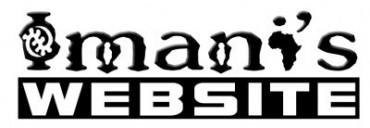 The website will also make accessible to its users, when available, all the relevant materials, resources and props need to implement the whole festival practically. This will include the retail of books, gifts, props, in addition to featuring suggestions, ideas and instructions of how to develop enjoyable family and community Kwanzaa activities.This website will also act as a vehicle through which to promote the Kwanzaa story through audio and visual productions, in addition to digitalised literary material accessible and featured on the site. These Kwanzaa resources will also be promoted through Imani’s Website internet network sites.
The website will also make accessible to its users, when available, all the relevant materials, resources and props need to implement the whole festival practically. This will include the retail of books, gifts, props, in addition to featuring suggestions, ideas and instructions of how to develop enjoyable family and community Kwanzaa activities.This website will also act as a vehicle through which to promote the Kwanzaa story through audio and visual productions, in addition to digitalised literary material accessible and featured on the site. These Kwanzaa resources will also be promoted through Imani’s Website internet network sites.
[/su_tab] [su_tab title=”THE KWANZAA STORY”]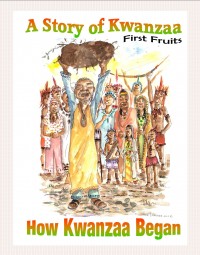 The Story of Kwanzaa, is a fictional story, writtten by Imani and illustrated by Dee Chandler, about how the festival of Kwanzaa began. Set in ancient Africa, the story introduces Mama and Baba Kwanzaa, literally mother and father Kwanzaa, to the reader. These individuals are the two main characters of the story who become icons of Kwanzaa as Father Christmas, St Nicholas or Santa Claus is to Christmas.
The Story of Kwanzaa, is a fictional story, writtten by Imani and illustrated by Dee Chandler, about how the festival of Kwanzaa began. Set in ancient Africa, the story introduces Mama and Baba Kwanzaa, literally mother and father Kwanzaa, to the reader. These individuals are the two main characters of the story who become icons of Kwanzaa as Father Christmas, St Nicholas or Santa Claus is to Christmas. The story takes the reader into the ancient African past to a village where the couple first lived called Iwaji, where the festival first took place. The story incorporates many traditional African themes, folklore and myths, as well as symbolic terms and references to ancient African history and culture. Encounters with strange and mysterious people, mythical animals and flying chariots, childless women, perceived tragedy and blessings, bring to the story those authentic traditional African themes that are symbolic of the deeply spiritual nature of African folklore that can be found in traditional stories found all over this vast continent.
The story takes the reader into the ancient African past to a village where the couple first lived called Iwaji, where the festival first took place. The story incorporates many traditional African themes, folklore and myths, as well as symbolic terms and references to ancient African history and culture. Encounters with strange and mysterious people, mythical animals and flying chariots, childless women, perceived tragedy and blessings, bring to the story those authentic traditional African themes that are symbolic of the deeply spiritual nature of African folklore that can be found in traditional stories found all over this vast continent.
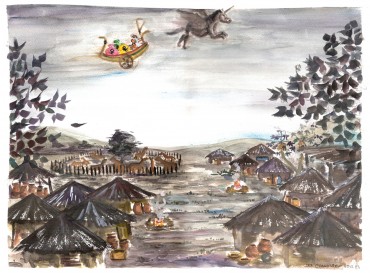 Utilising these important African themes and ideas as a backdrop and foundation, helps to introduce the Kwanzaa celebration to people at all levels and at all ages, from children to adults.
Utilising these important African themes and ideas as a backdrop and foundation, helps to introduce the Kwanzaa celebration to people at all levels and at all ages, from children to adults.
This Kwanzaa Story is therefore offered to help promote traditional African culture, its tradition of storytelling and at the same time introduce and raise peoples awareness of this New African international festival called Kwanzaa, particularly in the United Kingdom, the Caribbean & Africa.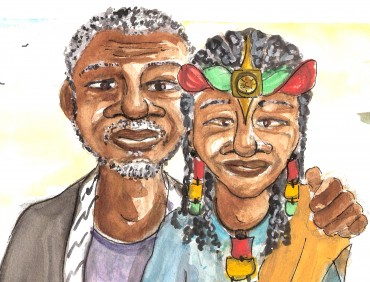 It is also offered as a medium and vehicle through which these main characters, Mama & Baba Kwanzaa in addition to the theme of the story, can be utilised to initiate activities in communities to help spread the awareness of this wonderful New African Festival, Kwanzaa.[/su_tab][/su_tabs][/su_spoiler][su_spoiler title=”THE KWANZAA PRINCIPLES & WORDS” style=”fancy” icon=”plus-square-1″][su_tabs][su_tab title=”LEARN”]Learn About The Kwanzaa Festival, words and symbols, what they are and how to pronounce them. [/su_tab] [su_tab title=”DAYS “]These are the Seven Days of Kwanzaa, called the;
It is also offered as a medium and vehicle through which these main characters, Mama & Baba Kwanzaa in addition to the theme of the story, can be utilised to initiate activities in communities to help spread the awareness of this wonderful New African Festival, Kwanzaa.[/su_tab][/su_tabs][/su_spoiler][su_spoiler title=”THE KWANZAA PRINCIPLES & WORDS” style=”fancy” icon=”plus-square-1″][su_tabs][su_tab title=”LEARN”]Learn About The Kwanzaa Festival, words and symbols, what they are and how to pronounce them. [/su_tab] [su_tab title=”DAYS “]These are the Seven Days of Kwanzaa, called the;
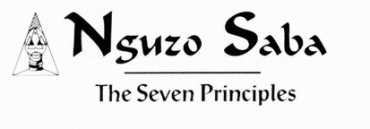 The Nguzo Saba (En-GOO-zoh Sah-BAH) (The Seven Principles)
The Nguzo Saba (En-GOO-zoh Sah-BAH) (The Seven Principles) 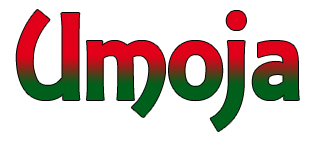 DAY 1, 26th = UMOJA (oo-MOE-jah) (UNITY) – To strive to achieve and maintain unity in the family, community, nation and race.
DAY 1, 26th = UMOJA (oo-MOE-jah) (UNITY) – To strive to achieve and maintain unity in the family, community, nation and race.
 DAY 2, 27th = KUJICHAGULIA (koo-jee-cha-goo-LEE-ah)
DAY 2, 27th = KUJICHAGULIA (koo-jee-cha-goo-LEE-ah)
(SELF DETERMINATION) – To always seek to define ourselves in order to think for ourselves and strive to lead our own destiny.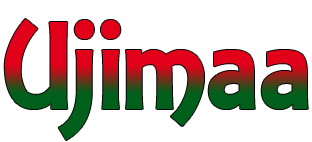 DAY 3, 28th = UJIMA (oo-JEE-mah) (COLLECTIVE WORK AND RESPONSIBILITY) – To always try to build and maintain our community together. Working with our Brothers & Sisters, sharing their problems and solving them together, in order to make our communities stronger.
DAY 3, 28th = UJIMA (oo-JEE-mah) (COLLECTIVE WORK AND RESPONSIBILITY) – To always try to build and maintain our community together. Working with our Brothers & Sisters, sharing their problems and solving them together, in order to make our communities stronger.
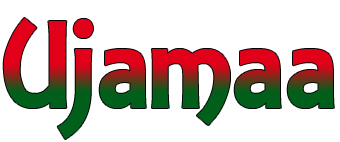 DAY 4, 29th = UJAMAA (oo-JAH-mah) (COOPERATIVE ECONOMICS) – To build and maintain our own companies, businesses and other enterprises together and to profit from them together.
DAY 4, 29th = UJAMAA (oo-JAH-mah) (COOPERATIVE ECONOMICS) – To build and maintain our own companies, businesses and other enterprises together and to profit from them together. 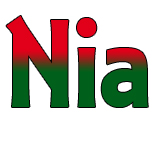 DAY 5, 30th = NIA (nee-AH) (PURPOSE) – To strive with every effort to help build and develop our communities and nation in order to restore our people to their traditional greatness.
DAY 5, 30th = NIA (nee-AH) (PURPOSE) – To strive with every effort to help build and develop our communities and nation in order to restore our people to their traditional greatness.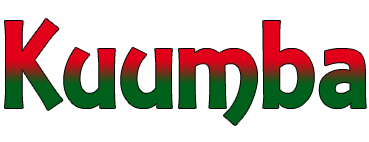 DAY 6, 31st = KUUMBA (koo-OOM-bah) (CREATIVITY) – To always do our utmost best, in everyway that we can express ourselves, artistically and creatively, to leave our community more beautiful and beneficial than when we inherited it.
DAY 6, 31st = KUUMBA (koo-OOM-bah) (CREATIVITY) – To always do our utmost best, in everyway that we can express ourselves, artistically and creatively, to leave our community more beautiful and beneficial than when we inherited it.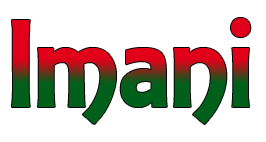 DAY 7, 1st = IMANI (ee-MAH-nee) (FAITH) – To believe with all our hearts in our Divine Self, our ancestors, parents, our teachers, our leaders, our people and the righteousness and victory of our struggle.
DAY 7, 1st = IMANI (ee-MAH-nee) (FAITH) – To believe with all our hearts in our Divine Self, our ancestors, parents, our teachers, our leaders, our people and the righteousness and victory of our struggle.  Adapted from definition given by; Dr Maulana R. Karenga, Creator of Kwanza ©1965[/su_tab] [su_tab title=”SYMBOLS”]
Adapted from definition given by; Dr Maulana R. Karenga, Creator of Kwanza ©1965[/su_tab] [su_tab title=”SYMBOLS”]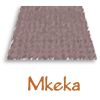
MKEKA
(M-kay-cah)
The Mkeka is a straw mat; all festival items are placed on this mat. It is a traditional item and therefore symbolises tradition, as the foundation upon which all else rests.
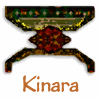 KINARA
KINARA
(Kee-nah-rah)
The Kinara is the candle-holder; that holds the seven candles and represents the original stalk or root from which we all sprang, i.e. our ancestors, our parents.
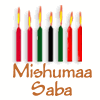 MSHUMAA SABA
MSHUMAA SABA
(Mee-shoo-maah Sah-BAH)
The seven candles; represent the Seven Principles (Nguzo Saba) the set of traditional African values that modern African people should live by, in order to rescue and reconstruct their lives in their own image and according to their own needs.
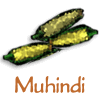 MUHINDI
MUHINDI
(Moo-heen-dee)
The ear of corn or corns; represents the offspring or product (the children) of the stalk or respective house. It also represents the ability or potential of the households offspring themselves, to become stalks (parents), and thus produce their own offspring. To demonstrate this, people often use as many ears of corn as children in the household. Every house has at least one ear of corn; for there is always the potential even if it has not yet been realised. Symbolised in this Kwanzaa Story as representing us, all African people, as the descendants of Iwaji.
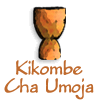 KIKOMBE CHA UMOJA
KIKOMBE CHA UMOJA
(Kee-coam-bay chah-oo-moe-jah)
The Unity Cup; symbolizes the first principle of Kwanzaa. It is used to pour the libation for our ancestors; and each member of the immediate family or extended family drinks from it, in a reinforcing gesture of honour, praise, collective work and commitment to continue the struggle began by our ancestors.
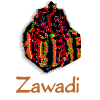 ZAWADI
ZAWADI
(Sah-wah-dee)
The presents (gifts); represent the fruits of the labours of the parents; the commitment made and kept by the children, therefore the rewards or seeds sown by the children themselves. Each year parents, guardians and adults should encourage the youth to always strive to do Goodness; Good Acts, Good Thoughts, Good Behaviour, Good Grades, etc., for the coming year, drawing upon the principles of the Nguzo Saba and reward them according to how well they achieved this over the previous year, or in anticipation of the coming year, if practicing Kwanzaa for the first time. Symbolised in this Kwanzaa Story as the gifts given by
Baba & Mama Kwanzaa.
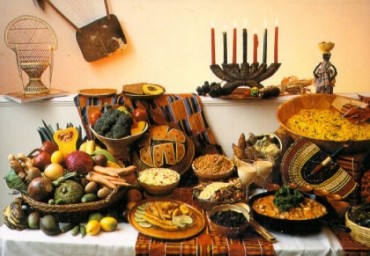 KARAMU (Ka- raa- mu) The feast; symbolizes the annual festival celebration that brings the community together, such as the Iwaji Yam festival of W. Africa, in order to exchange gifts, give thanks to the Creator for their accomplishments or fruits during the year. This feast is held on the night of December 31st (Kuumba) and includes food, drink, music, dance, conversation, laughter and ceremony. Symbolised in this Kwanzaa Story as the night before Baba & Mama, visits the homes of the descendents of Iwaji.[/su_tab] [su_tab title=”WORDS”]
KARAMU (Ka- raa- mu) The feast; symbolizes the annual festival celebration that brings the community together, such as the Iwaji Yam festival of W. Africa, in order to exchange gifts, give thanks to the Creator for their accomplishments or fruits during the year. This feast is held on the night of December 31st (Kuumba) and includes food, drink, music, dance, conversation, laughter and ceremony. Symbolised in this Kwanzaa Story as the night before Baba & Mama, visits the homes of the descendents of Iwaji.[/su_tab] [su_tab title=”WORDS”] NGUZO SABA Symbolizes the Seven Principles of Kwanzaa which were developed by Dr. Maulana Ron Karenga. The Nguzo Saba are social principles dealing with ways for us to relate to each other and rebuild our lives in our own images.
NGUZO SABA Symbolizes the Seven Principles of Kwanzaa which were developed by Dr. Maulana Ron Karenga. The Nguzo Saba are social principles dealing with ways for us to relate to each other and rebuild our lives in our own images.
 BENDERA YA TAIFA The Flag of Black Nationalism, adopted from the Flag of Allegiance, the official flag of The Rt. Honourable Marcus M. Garveys’ UNIA (Universal Negro Improvement Association 1914), symbolising the continued fight of African people to be Free and Liberated. The Red represents the blood of our ancestors and the blood that ties us together; Black is for the collective colour of all Black people, and Green represent our land, the African Continent, as well as life and new ideas that we must always strive to obtain.
BENDERA YA TAIFA The Flag of Black Nationalism, adopted from the Flag of Allegiance, the official flag of The Rt. Honourable Marcus M. Garveys’ UNIA (Universal Negro Improvement Association 1914), symbolising the continued fight of African people to be Free and Liberated. The Red represents the blood of our ancestors and the blood that ties us together; Black is for the collective colour of all Black people, and Green represent our land, the African Continent, as well as life and new ideas that we must always strive to obtain.
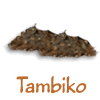 TAMBIKO Symbolises the Libation to honour in a special way our
TAMBIKO Symbolises the Libation to honour in a special way our
ancestors and a call to all those living in this life to strive as hard as they can to continue the work that these ancestors began. It therefore symbolises the respect for and the recognition of the contributions made by those before us, our history, heritage and most ancient traditions.
 HARAMBEE Symbolises a call for unity and a collective approach to work together to overcome a global struggle. The word means Let’s pull together!
HARAMBEE Symbolises a call for unity and a collective approach to work together to overcome a global struggle. The word means Let’s pull together! HABARI GANI What’s the news; what’s happening Swahili term used when greeting others.
HABARI GANI What’s the news; what’s happening Swahili term used when greeting others.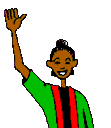 KWAHERI Swahili term used as an expression of parting with good wishes and an expectancy to meet again.[/su_tab][/su_tabs][/su_spoiler]
KWAHERI Swahili term used as an expression of parting with good wishes and an expectancy to meet again.[/su_tab][/su_tabs][/su_spoiler]
[su_spoiler title=”THE KWANZAA FESTIVAL GUIDE” style=”fancy” icon=”plus-square-1″][su_tabs][su_tab title=”WHAT?”]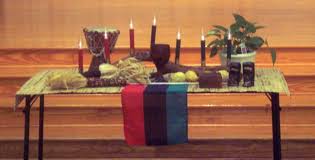 WHAT YOU WILL NEED TO HELP YOU DO KWANZAA
WHAT YOU WILL NEED TO HELP YOU DO KWANZAA
 1. Household Table
1. Household Table
2. A Tablecloth
3. Mkeka (Straw Mat)
4. Kinara (Candle holder x 7 stems)
5. Mishumma Saba (7 candles, 3 red, 3 green & 1 black)
6. Muhindi (ears of corn x 2 or more)
7. Kikombe Cha Umoja (The Unity Cup)
8. A drink to pour the Tambiko, libation.
9. Paper/Card etc. to make Kwanzaa decorations/crafts[/su_tab] [su_tab title=”THE GUIDE”]A Guide to Celebrating the Kwanzaa Festival: If you are celebrating Kwanzaa for the first time or would just like to learn more about how the festival is celebrated then here is a guide. This guide represents how the ceremonies within Kwanzaa are traditionally practiced and how the festival is celebrated over the seven days. We offer this only as a guide and people should adapt their celebration to suit their own particular circumstances, although keeping to the festival themes, e.g. you may not have all the right ceremonial implements, therefore use what ever you can as a substitute, for instance you haven’t got a Kinara (candle holder), so use 7 candle stands.
If you are celebrating Kwanzaa for the first time or would just like to learn more about how the festival is celebrated then here is a guide. This guide represents how the ceremonies within Kwanzaa are traditionally practiced and how the festival is celebrated over the seven days. We offer this only as a guide and people should adapt their celebration to suit their own particular circumstances, although keeping to the festival themes, e.g. you may not have all the right ceremonial implements, therefore use what ever you can as a substitute, for instance you haven’t got a Kinara (candle holder), so use 7 candle stands.
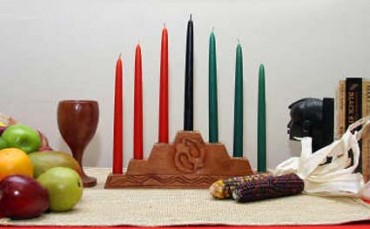 A note from Imani;
A note from Imani;
Do not allow access to material and physical implements to prevent you from practicing ceremonies that are actually spiritual in essence and nature. Through your own endeavours and sincerity, your physical and material implements are transformed into spiritual vessels & vehicles that will help you, your family and community connect with true African cultural identity.[/su_tab] [su_tab title=”STEPS”]Here are 3 STEPS to your right, to help prepare you, your household or community, for your Kwanzaa Celebration. A Note Before You Begin: On Fasting; Although not compulsory or part of the actual Kwanzaa Festival itself, many people fast 7 days before the festival begins. This fasting normally consists of abstinence from eating and drinking from sun-rise to sun-set and thereafter abstaining from meat & dairy products. However if you choose to keep this fast, please ensure you are able, health wise, if unsure first consult your doctor or seek other professional guidance[/su_tab] [su_tab title=”1″]STEP 1: Setting Up Your Home or Venue for the Kwanzaa Celebration:
A Note Before You Begin: On Fasting; Although not compulsory or part of the actual Kwanzaa Festival itself, many people fast 7 days before the festival begins. This fasting normally consists of abstinence from eating and drinking from sun-rise to sun-set and thereafter abstaining from meat & dairy products. However if you choose to keep this fast, please ensure you are able, health wise, if unsure first consult your doctor or seek other professional guidance[/su_tab] [su_tab title=”1″]STEP 1: Setting Up Your Home or Venue for the Kwanzaa Celebration: You must first prepare your home or venue to celebrate Kwanzaa. This is a very important part of the celebration as it brings the family or community together in one endeavour and so sets the platform and foundation upon which the festival will be set. It is also important to ensure that the whole house or venue is clean and tidy before you begin to setup for your Kwanzaa Celebration. It is best to form a family or community planning committee, to assign roles & duties for people to carry out before, during and even after the celebration.[/su_tab][su_tab title=”2″]
You must first prepare your home or venue to celebrate Kwanzaa. This is a very important part of the celebration as it brings the family or community together in one endeavour and so sets the platform and foundation upon which the festival will be set. It is also important to ensure that the whole house or venue is clean and tidy before you begin to setup for your Kwanzaa Celebration. It is best to form a family or community planning committee, to assign roles & duties for people to carry out before, during and even after the celebration.[/su_tab][su_tab title=”2″] STEP 2: Setting Up Your Kwanzaa Celebration Table:
STEP 2: Setting Up Your Kwanzaa Celebration Table: Identify a suitable area to set up your Kwanzaa Table; this will be the central or focal point for the family or community celebration. Place a clean tablecloth, preferable of cultural importance, upon the main table.
Identify a suitable area to set up your Kwanzaa Table; this will be the central or focal point for the family or community celebration. Place a clean tablecloth, preferable of cultural importance, upon the main table. 
 Start to place the Kwanzaa items and symbols in an organized and pleasurable way upon the table starting with the “Mkeka”, the straw or woven mat, this should also be of cultural importance if possible, but any straw mat will do. All other items can now be place upon or around the Mkeka which symbolizes the foundation upon which the festival rests.
Start to place the Kwanzaa items and symbols in an organized and pleasurable way upon the table starting with the “Mkeka”, the straw or woven mat, this should also be of cultural importance if possible, but any straw mat will do. All other items can now be place upon or around the Mkeka which symbolizes the foundation upon which the festival rests.
 Place the “Kinara”
Place the “Kinara”
(7 stem candle holder) Upon the Mkeka in a central but suitable area that will be easy and safe for young people to access, light and later blow out candles.
 Put the “Mishumaa Saba”
Put the “Mishumaa Saba”
(7 candles) into the Kinara,
Three green (right),
One black (centre) and
Three red (left).
 Place the “Muhindi” –
Place the “Muhindi” –
(ears of corn) on to the Mkeka.
Placing one ear of corn for each child; if there are no children or many children present, then place at least two ears to represent the potential of children or the children of the family & community.
 Now place the “Kikombe Cha Umoja”
Now place the “Kikombe Cha Umoja”
(the unity cup) on the Mkeka;
This cup represents the ancestors, the current and future family members, the community and our universe.
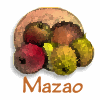 You can also place a bowl of fruit or vegetables on the table to represent harvest, produce and productivity.
You can also place a bowl of fruit or vegetables on the table to represent harvest, produce and productivity.
Remember Kwanzaa is about and also represents giving your/our First Fruits.
 You can continue to decorate your Kwanzaa table with other cultural crafts and items. Try not to overcrowd the table; many activities and Kwanzaa ceremonies are carried out on and around this table. This will prevent things from being constantly knocked over or interrupted during the festival.[/su_tab][su_tab title=”3″]STEP 3: Decorating the rest of your home or venue:
You can continue to decorate your Kwanzaa table with other cultural crafts and items. Try not to overcrowd the table; many activities and Kwanzaa ceremonies are carried out on and around this table. This will prevent things from being constantly knocked over or interrupted during the festival.[/su_tab][su_tab title=”3″]STEP 3: Decorating the rest of your home or venue:
 Using whatever material you desire, e.g. paper, card, cloth etc. make your own “Bendera Ya Taifa’s” (Flag of Allegiance, also known as the Marcus Garvey flag). The flag colours are Black/Red/Green, these are the Kwanzaa colours. Make or purchase one main flag to be displayed on the table or in a central location close to the table.
Using whatever material you desire, e.g. paper, card, cloth etc. make your own “Bendera Ya Taifa’s” (Flag of Allegiance, also known as the Marcus Garvey flag). The flag colours are Black/Red/Green, these are the Kwanzaa colours. Make or purchase one main flag to be displayed on the table or in a central location close to the table.
Also you can make as many other flags as necessary to decorate the home or venue. You can also make or purchase flags of symbolic importance to African people, e.g. Rasta Flag, red, gold, green and other African or Caribbean National flags etc.
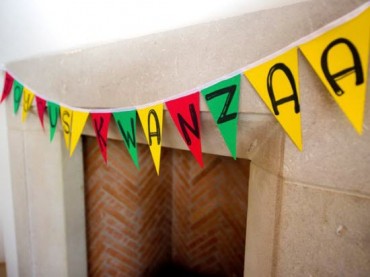 Design, create or purchase other materials and items to ensure that your home or venue truly reflects a cultural environment as well as a Kwanzaa theme and setting.[/su_tab][/su_tabs][/su_spoiler][su_spoiler title=”THE KWANZAA FESTIVAL ACTIVITIES” style=”fancy” icon=”plus-square-1″][su_tabs][su_tab title=”PLAN”]
Design, create or purchase other materials and items to ensure that your home or venue truly reflects a cultural environment as well as a Kwanzaa theme and setting.[/su_tab][/su_tabs][/su_spoiler][su_spoiler title=”THE KWANZAA FESTIVAL ACTIVITIES” style=”fancy” icon=”plus-square-1″][su_tabs][su_tab title=”PLAN”]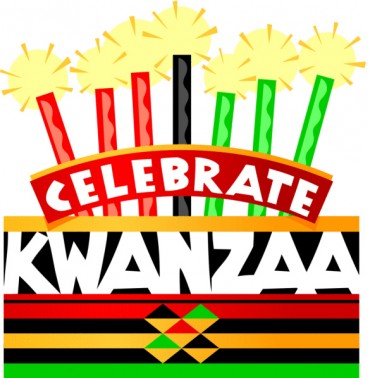 Here are some of the Daily Activities: People are encouraged to plan a full programme for celebrating Kwanzaa, preferably having activities on each day of the festival. Always try to make your daily activities relevant to the respective theme for that day and include all or as many members of the family or community when and where possible.[/su_tab][su_tab title=”GREET”]The Kwanzaa Greetings:
Here are some of the Daily Activities: People are encouraged to plan a full programme for celebrating Kwanzaa, preferably having activities on each day of the festival. Always try to make your daily activities relevant to the respective theme for that day and include all or as many members of the family or community when and where possible.[/su_tab][su_tab title=”GREET”]The Kwanzaa Greetings:
 During the Kwanzaa festival people use a special greeting, when they meet or see each other within their home and community.
During the Kwanzaa festival people use a special greeting, when they meet or see each other within their home and community.
On greeting people they say “Habari Gani” which means in Swahili “what is the news?” the person’s response should then be the word for that day, e.g. if on the 26th December, then the response would be “Umoja”, meaning unity the first day of Kwanzaa, if on the 27th then Kujichagulia would be the response, self-determination
and so on. When people are parting they say “Kwaheri” meaning “Good Wishes”[/su_tab][su_tab title=”CANDLES”]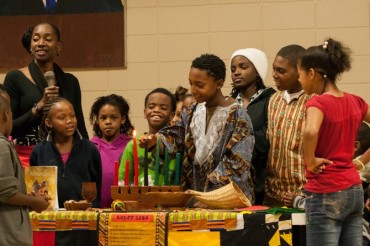 Lighting the Mishumaa Saba (7 Candles): On each day of the festival, at a fixed time, a candle is lit, preferably by the children, if it is safe for them to do so. Candles are lit starting with the centred Black candle and then normally from left to right, therefore on day one, “Umoja” the black candle is lit. Different children or people can light the candle on the different days.
Lighting the Mishumaa Saba (7 Candles): On each day of the festival, at a fixed time, a candle is lit, preferably by the children, if it is safe for them to do so. Candles are lit starting with the centred Black candle and then normally from left to right, therefore on day one, “Umoja” the black candle is lit. Different children or people can light the candle on the different days. Before the Candle is lit the host or MC must say to the person lighting the candle, “Habari Gani” (what is the news?) and the person must respond with the word or name for the correct day for which they are lighting the candle. Only when this response is correct can they then light the candle. After the candle is lit a discussion or activity commences. This is done each day and then repeated daily. Meaning that on day 2 for instance, two candles will be lit, and before lighting them the question is asked “Habari Gani” and the correct response should be given, preferably by the original person who had lit the candle. The blowing out of the candles is also a very exciting event and a great responsibility for the one chosen, it can be the child/person who lit it, or another.[/su_tab][su_tab title=”DISCUSS”]
Before the Candle is lit the host or MC must say to the person lighting the candle, “Habari Gani” (what is the news?) and the person must respond with the word or name for the correct day for which they are lighting the candle. Only when this response is correct can they then light the candle. After the candle is lit a discussion or activity commences. This is done each day and then repeated daily. Meaning that on day 2 for instance, two candles will be lit, and before lighting them the question is asked “Habari Gani” and the correct response should be given, preferably by the original person who had lit the candle. The blowing out of the candles is also a very exciting event and a great responsibility for the one chosen, it can be the child/person who lit it, or another.[/su_tab][su_tab title=”DISCUSS”]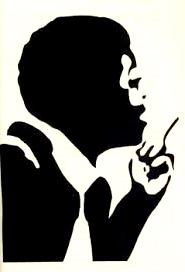 Discussions: After the candle is lit, the family or community members can have a light-hearted discussion on the meaning of the word used for that particular day, e.g. “Umoja” (unity), what it means to them, its significance and how they may help to contribute in achieving it. Connection and reflection should also be made in these discussions with days already commemorated.[/su_tab][su_tab title=”MUSIC”]
Discussions: After the candle is lit, the family or community members can have a light-hearted discussion on the meaning of the word used for that particular day, e.g. “Umoja” (unity), what it means to them, its significance and how they may help to contribute in achieving it. Connection and reflection should also be made in these discussions with days already commemorated.[/su_tab][su_tab title=”MUSIC”]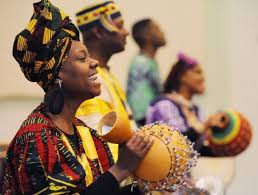 Music: Special culturally significant songs can be sung, played or listened to as part of the daily celebrations. This is particularly significant on the 6th day of Kwanzaa which falls on the 31st December (New Years Eve) and therefore represents “Kuumba” i.e. Creativity. It is also upon this day that the Kwanzaa festival is held, when lots of cultural music should be played, performed and heard. The drum should also be used throughout the festival, where and whenever appropriate, particularly during singing, dancing, recitals, addresses and announcements.[/su_tab][su_tab title=”ART”]
Music: Special culturally significant songs can be sung, played or listened to as part of the daily celebrations. This is particularly significant on the 6th day of Kwanzaa which falls on the 31st December (New Years Eve) and therefore represents “Kuumba” i.e. Creativity. It is also upon this day that the Kwanzaa festival is held, when lots of cultural music should be played, performed and heard. The drum should also be used throughout the festival, where and whenever appropriate, particularly during singing, dancing, recitals, addresses and announcements.[/su_tab][su_tab title=”ART”]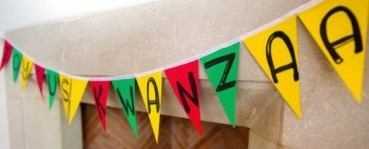 Arts & Crafts: People often make most if not all of their Kwanzaa decorations themselves, some decorations can also be purchased. These craft sessions serve to provide the family and community with an opportunity to design and create their own unique decorations, independently and yet still collectively, bringing it all together as one beautifully decorated, colourful Kwanzaa home or venue. Kwanzaa planners may wish to confine some arts & crafts activities to the 6th Day of Kwanzaa, “Kuumba” meaning creativity which is the festival day devoted to us celebrating and expressing our creativeness, this is also the day of the feast. However crafts can also be planned and made, long before the festival begins. When making cultural crafts to decorate your home or venue, remember to stay within the Kwanzaa & African cultural theme colours, you can design and make, sign’s displaying the words of the Nguzo Saba and other festival words. You can also make Kwanzaa cards for family members and friends as well as the Zawadi or Kwanzaa gifts to be given away on the final day of the festival, “Imani”, January 1st.[/su_tab][su_tab title=”STORY”]
Arts & Crafts: People often make most if not all of their Kwanzaa decorations themselves, some decorations can also be purchased. These craft sessions serve to provide the family and community with an opportunity to design and create their own unique decorations, independently and yet still collectively, bringing it all together as one beautifully decorated, colourful Kwanzaa home or venue. Kwanzaa planners may wish to confine some arts & crafts activities to the 6th Day of Kwanzaa, “Kuumba” meaning creativity which is the festival day devoted to us celebrating and expressing our creativeness, this is also the day of the feast. However crafts can also be planned and made, long before the festival begins. When making cultural crafts to decorate your home or venue, remember to stay within the Kwanzaa & African cultural theme colours, you can design and make, sign’s displaying the words of the Nguzo Saba and other festival words. You can also make Kwanzaa cards for family members and friends as well as the Zawadi or Kwanzaa gifts to be given away on the final day of the festival, “Imani”, January 1st.[/su_tab][su_tab title=”STORY”] 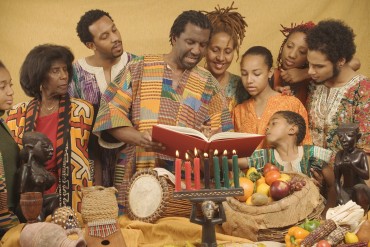 Storytelling: Parents and elders can also read a tale of Kwanzaa to their audience. The “A Story of Kwanzaa” by Imani, is such a tale and can either be read in one sitting or over the duration of the seven day festival. It is also anticipated that this particular Kwanzaa tale “A Story of Kwanzaa” will be developed into a play so communities and audiences can enjoy the Kwanzaa experience through drama and theatrical displays. This will also help introduce the Kwanzaa festival to new audiences. Other Kwanzaa stories and other cultural traditional African stories and plays can also be read, told or seen during the festival to help imbed the traditions and principles of Kwanzaa and the Nguzu Saba into your celebration, lives and conscious. These stories can be found in many cultural black books particularly Kwanzaa story books that can be purchased from local bookshops or online. Look out for forthcoming community local, regional or national Kwanzaa events, as these are usually packed with a full exciting and entertaining programme of activities that often includes spoken word performances. Make it a point to attend these events in a group as a family or community, when possible.[/su_tab][su_tab title=”PLAY”]
Storytelling: Parents and elders can also read a tale of Kwanzaa to their audience. The “A Story of Kwanzaa” by Imani, is such a tale and can either be read in one sitting or over the duration of the seven day festival. It is also anticipated that this particular Kwanzaa tale “A Story of Kwanzaa” will be developed into a play so communities and audiences can enjoy the Kwanzaa experience through drama and theatrical displays. This will also help introduce the Kwanzaa festival to new audiences. Other Kwanzaa stories and other cultural traditional African stories and plays can also be read, told or seen during the festival to help imbed the traditions and principles of Kwanzaa and the Nguzu Saba into your celebration, lives and conscious. These stories can be found in many cultural black books particularly Kwanzaa story books that can be purchased from local bookshops or online. Look out for forthcoming community local, regional or national Kwanzaa events, as these are usually packed with a full exciting and entertaining programme of activities that often includes spoken word performances. Make it a point to attend these events in a group as a family or community, when possible.[/su_tab][su_tab title=”PLAY”]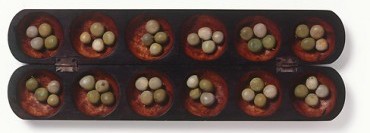 Games & Play: Traditional and cultural games and quizzes should be played throughout the festival, by those participating. These games can be purchased or made during crafts sessions, there are many traditional Africa games to choose from such as Oware or Mankala (a game played with seeds), Senet (an Ancient Egyptian game), Yote (West African checkers) etc. These games and others can be found and downloaded or purchased online. Alternatively you can design and create your own Kwanzaa games. Why not duplicate the quizzes in this book as a Kwanzaa activity.[/su_tab][su_tab title=”FEAST”]Karamu; the Kwanzaa Festival Feast: The Kwanzaa Feast is held on the 6th Day i.e. the 31st December (New Years Eve). This is a very important event within the festival that helps to bring the family and community together as well as brings everyone closer to their African Heritage. The feast should be served within a central place in the home or venue, placing a large “Mkeka” or cultural tablecloth either on the floor or on a dinning table, upon which the feast is laid.
Games & Play: Traditional and cultural games and quizzes should be played throughout the festival, by those participating. These games can be purchased or made during crafts sessions, there are many traditional Africa games to choose from such as Oware or Mankala (a game played with seeds), Senet (an Ancient Egyptian game), Yote (West African checkers) etc. These games and others can be found and downloaded or purchased online. Alternatively you can design and create your own Kwanzaa games. Why not duplicate the quizzes in this book as a Kwanzaa activity.[/su_tab][su_tab title=”FEAST”]Karamu; the Kwanzaa Festival Feast: The Kwanzaa Feast is held on the 6th Day i.e. the 31st December (New Years Eve). This is a very important event within the festival that helps to bring the family and community together as well as brings everyone closer to their African Heritage. The feast should be served within a central place in the home or venue, placing a large “Mkeka” or cultural tablecloth either on the floor or on a dinning table, upon which the feast is laid.
 The food should be laid out in a way that people can easily serve themselves, in accordance with traditional African communal eating customs. The menu for the Kwanzaa feast should include cultural foods, such as yams, sweat potatoes, rice, tropical vegetables and fruits, alongside exotic traditional and cultural drinks. Upon this feasting day, a full entertainment and educational programme should be presented that includes, cultural music & dance, cultural songs sung and performed by family or community members, recitals, poetry, games and other enjoyable activities. The feast should be held in a colourful, vibrant and cultural environment, with the Kwanzaa colors and themes taking prominent positions.[/su_tab][su_tab title=”LIBATION”]
The food should be laid out in a way that people can easily serve themselves, in accordance with traditional African communal eating customs. The menu for the Kwanzaa feast should include cultural foods, such as yams, sweat potatoes, rice, tropical vegetables and fruits, alongside exotic traditional and cultural drinks. Upon this feasting day, a full entertainment and educational programme should be presented that includes, cultural music & dance, cultural songs sung and performed by family or community members, recitals, poetry, games and other enjoyable activities. The feast should be held in a colourful, vibrant and cultural environment, with the Kwanzaa colors and themes taking prominent positions.[/su_tab][su_tab title=”LIBATION”]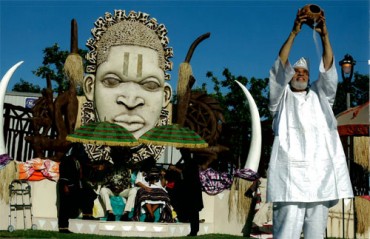 Kwanzaa Tambiko; the Libation: During this feast, the host should gather all present to drink from the “Kikombe Cha Umoja”. However before this cup and drink is passed around the host or MC should first pour some of the initial contents onto the floor, as an offering and libation to the One God and to our ancestors, this is called the “Tambiko”. How this is done? Every time a persons name is called; either a cultural icon or family member who has passed on; a little of the contents of the Kikombe Cha Umoja is poured to the ground or into a container.
Kwanzaa Tambiko; the Libation: During this feast, the host should gather all present to drink from the “Kikombe Cha Umoja”. However before this cup and drink is passed around the host or MC should first pour some of the initial contents onto the floor, as an offering and libation to the One God and to our ancestors, this is called the “Tambiko”. How this is done? Every time a persons name is called; either a cultural icon or family member who has passed on; a little of the contents of the Kikombe Cha Umoja is poured to the ground or into a container.  After a name is called and the libation poured for each person or entity remembered, the person that pours the libation can ask the audience “Habari Gani” meaning “What is the News?” then they can respond by all saying, simultaneously “Harambee” meaning “Lets pull together”. After the Tambiko (libation) this cup is then passed around to all the celebrants. Participants should also be encouraged to recite together the African Pledge of Allegiance, or some other culturally significant declaration, after the libation and drinking ceremony has completed. The Tambiko, libation can also be done daily, as part of the daily Kwanzaa ceremonies.[/su_tab][su_tab title=”GIFTS”]
After a name is called and the libation poured for each person or entity remembered, the person that pours the libation can ask the audience “Habari Gani” meaning “What is the News?” then they can respond by all saying, simultaneously “Harambee” meaning “Lets pull together”. After the Tambiko (libation) this cup is then passed around to all the celebrants. Participants should also be encouraged to recite together the African Pledge of Allegiance, or some other culturally significant declaration, after the libation and drinking ceremony has completed. The Tambiko, libation can also be done daily, as part of the daily Kwanzaa ceremonies.[/su_tab][su_tab title=”GIFTS”] 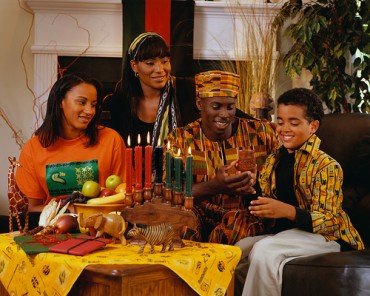 Zawadi; Giving Gifts: On the final day of Kwanzaa, January 1st (New Years Day) that is “Imani” which means “Faith” the gifts are given. These gifts called the “Zawadi” must be of some cultural or educational importance or significance and not a gift just for the sake of giving presents. Gifts made by the giver themselves are of the highest value and can represent anything, as their significance is in the fact that personal thought, time, effort, action, expression and creativeness has gone into them, which cannot be valued or devalued. Many of these gifts can be made throughout the festival activities and if possible especially on the 6th day “Kuumba”.
Zawadi; Giving Gifts: On the final day of Kwanzaa, January 1st (New Years Day) that is “Imani” which means “Faith” the gifts are given. These gifts called the “Zawadi” must be of some cultural or educational importance or significance and not a gift just for the sake of giving presents. Gifts made by the giver themselves are of the highest value and can represent anything, as their significance is in the fact that personal thought, time, effort, action, expression and creativeness has gone into them, which cannot be valued or devalued. Many of these gifts can be made throughout the festival activities and if possible especially on the 6th day “Kuumba”. 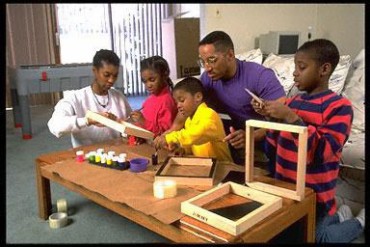 Everyone should try themselves to make at least one gift to give away. Also on the final day of the festival “Imani” each celebrant offers as their own personal and unique gift to the family, community or nation some New Years Resolutions. These resolutions should reflect as well as represent the method or actions to be taken that will help them to adhere to and achieve the principles of the “Nguzu Saba”, throughout the coming year.
Everyone should try themselves to make at least one gift to give away. Also on the final day of the festival “Imani” each celebrant offers as their own personal and unique gift to the family, community or nation some New Years Resolutions. These resolutions should reflect as well as represent the method or actions to be taken that will help them to adhere to and achieve the principles of the “Nguzu Saba”, throughout the coming year.  Normally and traditionally it is the rewards for the accomplishment of the previous year’s resolutions that people are given the Zawadi gifts at the end of the year in recognition of this. These accomplishments representing and symbolic to their “First Fruits” i.e. “Kwanzaa”.
Normally and traditionally it is the rewards for the accomplishment of the previous year’s resolutions that people are given the Zawadi gifts at the end of the year in recognition of this. These accomplishments representing and symbolic to their “First Fruits” i.e. “Kwanzaa”. We hope this GUIDE will be of benefit and use to you, when next you Celebrate Kwanzaa . Enjoy your Kwanzaa Festival and have a “Happy Kwanzaa”[/su_tab][/su_tabs][/su_spoiler]
We hope this GUIDE will be of benefit and use to you, when next you Celebrate Kwanzaa . Enjoy your Kwanzaa Festival and have a “Happy Kwanzaa”[/su_tab][/su_tabs][/su_spoiler]
Adinkra Symbol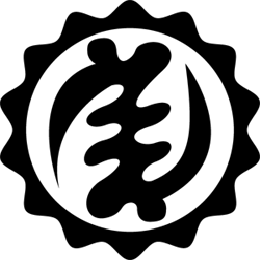 Name: Nyame Ye Ohene
Name: Nyame Ye Ohene
Meaning: God is King
Symbolising: Majesty and Supremacy
Permanent link to this article: http://imaniswebsite.co.uk/u-k-kwanzaa-campaign/



 KWANZAA, is an African-American cultural festival conceived and developed by Dr. Maulana Ron Karenga and was first celebrated on December 26, 1966. Today KWANZAA is celebrated by many millions of African people throughout the world.
KWANZAA, is an African-American cultural festival conceived and developed by Dr. Maulana Ron Karenga and was first celebrated on December 26, 1966. Today KWANZAA is celebrated by many millions of African people throughout the world. These seven principles were adopted by Dr Karenga “to introduce and reinforce seven basic values of African culture which contribute to building and reinforcing family, community and culture among African American people as well as Africans throughout the world African community”. The NGUZO SABA therefore stands at the heart and origin of KWANZAA and reflects the similarity found in the moral, spiritual, social, communal codes and value systems adhered to within traditional African customs, found and practiced throughout the continent. Serving therefore as a set of principles that can help to maintain and sustain African people and their communities over many more millennia.
These seven principles were adopted by Dr Karenga “to introduce and reinforce seven basic values of African culture which contribute to building and reinforcing family, community and culture among African American people as well as Africans throughout the world African community”. The NGUZO SABA therefore stands at the heart and origin of KWANZAA and reflects the similarity found in the moral, spiritual, social, communal codes and value systems adhered to within traditional African customs, found and practiced throughout the continent. Serving therefore as a set of principles that can help to maintain and sustain African people and their communities over many more millennia. The purpose of this Kwanzaa Campaign is to promote, market and increase the awareness of people in Britain to the annual Kwanzaa Festival, founded and developed by Dr. Maulana Ron Karenga in the U.S in the 1966 and held between the 26th December to 1st January, as well as to support individuals, families, groups or organisations, initiate the Kwanzaa celebration within their lives, amongst their users and/or in their communities.
The purpose of this Kwanzaa Campaign is to promote, market and increase the awareness of people in Britain to the annual Kwanzaa Festival, founded and developed by Dr. Maulana Ron Karenga in the U.S in the 1966 and held between the 26th December to 1st January, as well as to support individuals, families, groups or organisations, initiate the Kwanzaa celebration within their lives, amongst their users and/or in their communities. The website will also make accessible to its users, when available, all the relevant materials, resources and props need to implement the whole festival practically. This will include the retail of books, gifts, props, in addition to featuring suggestions, ideas and instructions of how to develop enjoyable family and community Kwanzaa activities.This website will also act as a vehicle through which to promote the Kwanzaa story through audio and visual productions, in addition to digitalised literary material accessible and featured on the site. These Kwanzaa resources will also be promoted through Imani’s Website internet network sites.
The website will also make accessible to its users, when available, all the relevant materials, resources and props need to implement the whole festival practically. This will include the retail of books, gifts, props, in addition to featuring suggestions, ideas and instructions of how to develop enjoyable family and community Kwanzaa activities.This website will also act as a vehicle through which to promote the Kwanzaa story through audio and visual productions, in addition to digitalised literary material accessible and featured on the site. These Kwanzaa resources will also be promoted through Imani’s Website internet network sites. The Story of Kwanzaa, is a fictional story, writtten by Imani and illustrated by Dee Chandler, about how the festival of Kwanzaa began. Set in ancient Africa, the story introduces Mama and Baba Kwanzaa, literally mother and father Kwanzaa, to the reader. These individuals are the two main characters of the story who become icons of Kwanzaa as Father Christmas, St Nicholas or Santa Claus is to Christmas.
The Story of Kwanzaa, is a fictional story, writtten by Imani and illustrated by Dee Chandler, about how the festival of Kwanzaa began. Set in ancient Africa, the story introduces Mama and Baba Kwanzaa, literally mother and father Kwanzaa, to the reader. These individuals are the two main characters of the story who become icons of Kwanzaa as Father Christmas, St Nicholas or Santa Claus is to Christmas. Utilising these important African themes and ideas as a backdrop and foundation, helps to introduce the Kwanzaa celebration to people at all levels and at all ages, from children to adults.
Utilising these important African themes and ideas as a backdrop and foundation, helps to introduce the Kwanzaa celebration to people at all levels and at all ages, from children to adults. It is also offered as a medium and vehicle through which these main characters, Mama & Baba Kwanzaa in addition to the theme of the story, can be utilised to initiate activities in communities to help spread the awareness of this wonderful New African Festival, Kwanzaa.[/su_tab][/su_tabs][/su_spoiler][su_spoiler title=”THE KWANZAA PRINCIPLES & WORDS” style=”fancy” icon=”plus-square-1″][su_tabs][su_tab title=”LEARN”]Learn About The Kwanzaa Festival, words and symbols, what they are and how to pronounce them. [/su_tab] [su_tab title=”DAYS “]These are the Seven Days of Kwanzaa, called the;
It is also offered as a medium and vehicle through which these main characters, Mama & Baba Kwanzaa in addition to the theme of the story, can be utilised to initiate activities in communities to help spread the awareness of this wonderful New African Festival, Kwanzaa.[/su_tab][/su_tabs][/su_spoiler][su_spoiler title=”THE KWANZAA PRINCIPLES & WORDS” style=”fancy” icon=”plus-square-1″][su_tabs][su_tab title=”LEARN”]Learn About The Kwanzaa Festival, words and symbols, what they are and how to pronounce them. [/su_tab] [su_tab title=”DAYS “]These are the Seven Days of Kwanzaa, called the;














 BENDERA YA TAIFA The Flag of Black Nationalism, adopted from the Flag of Allegiance, the official flag of The Rt. Honourable Marcus M. Garveys’ UNIA (Universal Negro Improvement Association 1914), symbolising the continued fight of African people to be Free and Liberated. The Red represents the blood of our ancestors and the blood that ties us together; Black is for the collective colour of all Black people, and Green represent our land, the African Continent, as well as life and new ideas that we must always strive to obtain.
BENDERA YA TAIFA The Flag of Black Nationalism, adopted from the Flag of Allegiance, the official flag of The Rt. Honourable Marcus M. Garveys’ UNIA (Universal Negro Improvement Association 1914), symbolising the continued fight of African people to be Free and Liberated. The Red represents the blood of our ancestors and the blood that ties us together; Black is for the collective colour of all Black people, and Green represent our land, the African Continent, as well as life and new ideas that we must always strive to obtain. TAMBIKO Symbolises the Libation to honour in a special way our
TAMBIKO Symbolises the Libation to honour in a special way our HARAMBEE Symbolises a call for unity and a collective approach to work together to overcome a global struggle. The word means Let’s pull together!
HARAMBEE Symbolises a call for unity and a collective approach to work together to overcome a global struggle. The word means Let’s pull together! HABARI GANI What’s the news; what’s happening Swahili term used when greeting others.
HABARI GANI What’s the news; what’s happening Swahili term used when greeting others. KWAHERI Swahili term used as an expression of parting with good wishes and an expectancy to meet again.[/su_tab][/su_tabs][/su_spoiler]
KWAHERI Swahili term used as an expression of parting with good wishes and an expectancy to meet again.[/su_tab][/su_tabs][/su_spoiler] WHAT YOU WILL NEED TO HELP YOU DO KWANZAA
WHAT YOU WILL NEED TO HELP YOU DO KWANZAA A note from Imani;
A note from Imani; You can also place a bowl of fruit or vegetables on the table to represent harvest, produce and productivity.
You can also place a bowl of fruit or vegetables on the table to represent harvest, produce and productivity. Design, create or purchase other materials and items to ensure that your home or venue truly reflects a cultural environment as well as a Kwanzaa theme and setting.[/su_tab][/su_tabs][/su_spoiler][su_spoiler title=”THE KWANZAA FESTIVAL ACTIVITIES” style=”fancy” icon=”plus-square-1″][su_tabs][su_tab title=”PLAN”]
Design, create or purchase other materials and items to ensure that your home or venue truly reflects a cultural environment as well as a Kwanzaa theme and setting.[/su_tab][/su_tabs][/su_spoiler][su_spoiler title=”THE KWANZAA FESTIVAL ACTIVITIES” style=”fancy” icon=”plus-square-1″][su_tabs][su_tab title=”PLAN”] Here are some of the Daily Activities: People are encouraged to plan a full programme for celebrating Kwanzaa, preferably having activities on each day of the festival. Always try to make your daily activities relevant to the respective theme for that day and include all or as many members of the family or community when and where possible.[/su_tab][su_tab title=”GREET”]The Kwanzaa Greetings:
Here are some of the Daily Activities: People are encouraged to plan a full programme for celebrating Kwanzaa, preferably having activities on each day of the festival. Always try to make your daily activities relevant to the respective theme for that day and include all or as many members of the family or community when and where possible.[/su_tab][su_tab title=”GREET”]The Kwanzaa Greetings: Lighting the Mishumaa Saba (7 Candles): On each day of the festival, at a fixed time, a candle is lit, preferably by the children, if it is safe for them to do so. Candles are lit starting with the centred Black candle and then normally from left to right, therefore on day one, “Umoja” the black candle is lit. Different children or people can light the candle on the different days.
Lighting the Mishumaa Saba (7 Candles): On each day of the festival, at a fixed time, a candle is lit, preferably by the children, if it is safe for them to do so. Candles are lit starting with the centred Black candle and then normally from left to right, therefore on day one, “Umoja” the black candle is lit. Different children or people can light the candle on the different days. Discussions: After the candle is lit, the family or community members can have a light-hearted discussion on the meaning of the word used for that particular day, e.g. “Umoja” (unity), what it means to them, its significance and how they may help to contribute in achieving it. Connection and reflection should also be made in these discussions with days already commemorated.[/su_tab][su_tab title=”MUSIC”]
Discussions: After the candle is lit, the family or community members can have a light-hearted discussion on the meaning of the word used for that particular day, e.g. “Umoja” (unity), what it means to them, its significance and how they may help to contribute in achieving it. Connection and reflection should also be made in these discussions with days already commemorated.[/su_tab][su_tab title=”MUSIC”] Music: Special culturally significant songs can be sung, played or listened to as part of the daily celebrations. This is particularly significant on the 6th day of Kwanzaa which falls on the 31st December (New Years Eve) and therefore represents “Kuumba” i.e. Creativity. It is also upon this day that the Kwanzaa festival is held, when lots of cultural music should be played, performed and heard. The drum should also be used throughout the festival, where and whenever appropriate, particularly during singing, dancing, recitals, addresses and announcements.[/su_tab][su_tab title=”ART”]
Music: Special culturally significant songs can be sung, played or listened to as part of the daily celebrations. This is particularly significant on the 6th day of Kwanzaa which falls on the 31st December (New Years Eve) and therefore represents “Kuumba” i.e. Creativity. It is also upon this day that the Kwanzaa festival is held, when lots of cultural music should be played, performed and heard. The drum should also be used throughout the festival, where and whenever appropriate, particularly during singing, dancing, recitals, addresses and announcements.[/su_tab][su_tab title=”ART”] Arts & Crafts: People often make most if not all of their Kwanzaa decorations themselves, some decorations can also be purchased. These craft sessions serve to provide the family and community with an opportunity to design and create their own unique decorations, independently and yet still collectively, bringing it all together as one beautifully decorated, colourful Kwanzaa home or venue. Kwanzaa planners may wish to confine some arts & crafts activities to the 6th Day of Kwanzaa, “Kuumba” meaning creativity which is the festival day devoted to us celebrating and expressing our creativeness, this is also the day of the feast. However crafts can also be planned and made, long before the festival begins. When making cultural crafts to decorate your home or venue, remember to stay within the Kwanzaa & African cultural theme colours, you can design and make, sign’s displaying the words of the Nguzo Saba and other festival words. You can also make Kwanzaa cards for family members and friends as well as the Zawadi or Kwanzaa gifts to be given away on the final day of the festival, “Imani”, January 1st.[/su_tab][su_tab title=”STORY”]
Arts & Crafts: People often make most if not all of their Kwanzaa decorations themselves, some decorations can also be purchased. These craft sessions serve to provide the family and community with an opportunity to design and create their own unique decorations, independently and yet still collectively, bringing it all together as one beautifully decorated, colourful Kwanzaa home or venue. Kwanzaa planners may wish to confine some arts & crafts activities to the 6th Day of Kwanzaa, “Kuumba” meaning creativity which is the festival day devoted to us celebrating and expressing our creativeness, this is also the day of the feast. However crafts can also be planned and made, long before the festival begins. When making cultural crafts to decorate your home or venue, remember to stay within the Kwanzaa & African cultural theme colours, you can design and make, sign’s displaying the words of the Nguzo Saba and other festival words. You can also make Kwanzaa cards for family members and friends as well as the Zawadi or Kwanzaa gifts to be given away on the final day of the festival, “Imani”, January 1st.[/su_tab][su_tab title=”STORY”]  Storytelling: Parents and elders can also read a tale of Kwanzaa to their audience. The “A Story of Kwanzaa” by Imani, is such a tale and can either be read in one sitting or over the duration of the seven day festival. It is also anticipated that this particular Kwanzaa tale “A Story of Kwanzaa” will be developed into a play so communities and audiences can enjoy the Kwanzaa experience through drama and theatrical displays. This will also help introduce the Kwanzaa festival to new audiences. Other Kwanzaa stories and other cultural traditional African stories and plays can also be read, told or seen during the festival to help imbed the traditions and principles of Kwanzaa and the Nguzu Saba into your celebration, lives and conscious. These stories can be found in many cultural black books particularly Kwanzaa story books that can be purchased from local bookshops or online. Look out for forthcoming community local, regional or national Kwanzaa events, as these are usually packed with a full exciting and entertaining programme of activities that often includes spoken word performances. Make it a point to attend these events in a group as a family or community, when possible.[/su_tab][su_tab title=”PLAY”]
Storytelling: Parents and elders can also read a tale of Kwanzaa to their audience. The “A Story of Kwanzaa” by Imani, is such a tale and can either be read in one sitting or over the duration of the seven day festival. It is also anticipated that this particular Kwanzaa tale “A Story of Kwanzaa” will be developed into a play so communities and audiences can enjoy the Kwanzaa experience through drama and theatrical displays. This will also help introduce the Kwanzaa festival to new audiences. Other Kwanzaa stories and other cultural traditional African stories and plays can also be read, told or seen during the festival to help imbed the traditions and principles of Kwanzaa and the Nguzu Saba into your celebration, lives and conscious. These stories can be found in many cultural black books particularly Kwanzaa story books that can be purchased from local bookshops or online. Look out for forthcoming community local, regional or national Kwanzaa events, as these are usually packed with a full exciting and entertaining programme of activities that often includes spoken word performances. Make it a point to attend these events in a group as a family or community, when possible.[/su_tab][su_tab title=”PLAY”] Games & Play: Traditional and cultural games and quizzes should be played throughout the festival, by those participating. These games can be purchased or made during crafts sessions, there are many traditional Africa games to choose from such as Oware or Mankala (a game played with seeds), Senet (an Ancient Egyptian game), Yote (West African checkers) etc. These games and others can be found and downloaded or purchased online. Alternatively you can design and create your own Kwanzaa games. Why not duplicate the quizzes in this book as a Kwanzaa activity.[/su_tab][su_tab title=”FEAST”]Karamu; the Kwanzaa Festival Feast: The Kwanzaa Feast is held on the 6th Day i.e. the 31st December (New Years Eve). This is a very important event within the festival that helps to bring the family and community together as well as brings everyone closer to their African Heritage. The feast should be served within a central place in the home or venue, placing a large “Mkeka” or cultural tablecloth either on the floor or on a dinning table, upon which the feast is laid.
Games & Play: Traditional and cultural games and quizzes should be played throughout the festival, by those participating. These games can be purchased or made during crafts sessions, there are many traditional Africa games to choose from such as Oware or Mankala (a game played with seeds), Senet (an Ancient Egyptian game), Yote (West African checkers) etc. These games and others can be found and downloaded or purchased online. Alternatively you can design and create your own Kwanzaa games. Why not duplicate the quizzes in this book as a Kwanzaa activity.[/su_tab][su_tab title=”FEAST”]Karamu; the Kwanzaa Festival Feast: The Kwanzaa Feast is held on the 6th Day i.e. the 31st December (New Years Eve). This is a very important event within the festival that helps to bring the family and community together as well as brings everyone closer to their African Heritage. The feast should be served within a central place in the home or venue, placing a large “Mkeka” or cultural tablecloth either on the floor or on a dinning table, upon which the feast is laid. Kwanzaa Tambiko; the Libation: During this feast, the host should gather all present to drink from the “Kikombe Cha Umoja”. However before this cup and drink is passed around the host or MC should first pour some of the initial contents onto the floor, as an offering and libation to the One God and to our ancestors, this is called the “Tambiko”. How this is done? Every time a persons name is called; either a cultural icon or family member who has passed on; a little of the contents of the Kikombe Cha Umoja is poured to the ground or into a container.
Kwanzaa Tambiko; the Libation: During this feast, the host should gather all present to drink from the “Kikombe Cha Umoja”. However before this cup and drink is passed around the host or MC should first pour some of the initial contents onto the floor, as an offering and libation to the One God and to our ancestors, this is called the “Tambiko”. How this is done? Every time a persons name is called; either a cultural icon or family member who has passed on; a little of the contents of the Kikombe Cha Umoja is poured to the ground or into a container.  Zawadi; Giving Gifts: On the final day of Kwanzaa, January 1st (New Years Day) that is “Imani” which means “Faith” the gifts are given. These gifts called the “Zawadi” must be of some cultural or educational importance or significance and not a gift just for the sake of giving presents. Gifts made by the giver themselves are of the highest value and can represent anything, as their significance is in the fact that personal thought, time, effort, action, expression and creativeness has gone into them, which cannot be valued or devalued. Many of these gifts can be made throughout the festival activities and if possible especially on the 6th day “Kuumba”.
Zawadi; Giving Gifts: On the final day of Kwanzaa, January 1st (New Years Day) that is “Imani” which means “Faith” the gifts are given. These gifts called the “Zawadi” must be of some cultural or educational importance or significance and not a gift just for the sake of giving presents. Gifts made by the giver themselves are of the highest value and can represent anything, as their significance is in the fact that personal thought, time, effort, action, expression and creativeness has gone into them, which cannot be valued or devalued. Many of these gifts can be made throughout the festival activities and if possible especially on the 6th day “Kuumba”.  Everyone should try themselves to make at least one gift to give away. Also on the final day of the festival “Imani” each celebrant offers as their own personal and unique gift to the family, community or nation some New Years Resolutions. These resolutions should reflect as well as represent the method or actions to be taken that will help them to adhere to and achieve the principles of the “Nguzu Saba”, throughout the coming year.
Everyone should try themselves to make at least one gift to give away. Also on the final day of the festival “Imani” each celebrant offers as their own personal and unique gift to the family, community or nation some New Years Resolutions. These resolutions should reflect as well as represent the method or actions to be taken that will help them to adhere to and achieve the principles of the “Nguzu Saba”, throughout the coming year. 